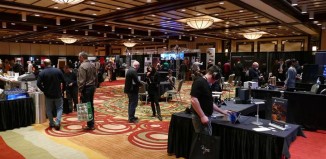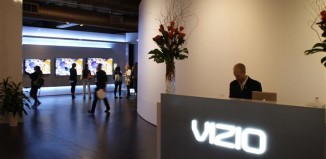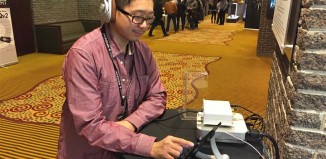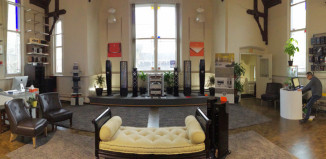LCD TV (LED-Backlit) Group Test With Reviews of Toshiba REGZA 46SV670U, Samsung UN46B6000 and Sharp LC-40LE700UN

Suave Kajko and Neil Underwood
Choosing a flat panel LCD TV has recently gotten a little more complicated - for those who care about performance anyway. Since LCD TVs were first introduced, manufacturers have strived to achieve the same level of performance that plasma technology is capable of. Perhaps the biggest Achilles’ heel for LCD technology has been the inability to display deep blacks. As a result LCD TVs have never been able to match the black levels, contrast ratio and overall colour reproduction that video enthusiasts enjoy on their plasma TVs. But the recent development of LED backlight technology is finally allowing LCD TVs to achieve truly deep blacks and vastly improved contrast ratios. So how does the new generation of LED-backlit LCD TVs look? I’m glad you asked!
Earlier this fall, we asked Samsung, Toshiba and Sharp to send us their latest LED-backlit LCD 1080p TVs so that we could put them to the test in a side-by-side evaluation. What made this group test particularly interesting is the fact that each of these TVs uses a different variation of the LED backlighting technology. And don’t be fooled by marketing terms. Companies like Samsung are labeling these TVs as “LED TVs” - which is misleading as there is no such thing. These are LCD TVs that use LED backlights. Our sources were a Pioneer Elite BDP-95FD Blu-ray player and a Rogers HD PVR, connected to an Audio Authority 1 to 4 HDMI distribution amp/splitter (model 1394A), allowing all three TVs to display the source at the same time.
In our tests below we first evaluate the video processing and de-interlacing of each of the TVs using the Silicon Optix test discs. Then we evaluate the TVs’ picture performance out of the box (in the Movie preset mode) and after a basic calibration with the Spears & Munsil High Definition Benchmark Blu-ray disc and a colour filter. Our test scenes included clips from Discovery HD shows (from the HD PVR) and various standard DVD and Blu-ray movies.
Lighting Up the Old School Way
In plasma, OLED and even tube TVs each pixel emits its own light. Pixels of LCD TVs on the other hand don’t emit any light - an LCD is a screen with a massive number of tiny doors that open and close. Therefore LCD TVs require a backlight that sits behind the screen. Since their introduction, LCD screens have been using an array of CCFLs (Cold Cathode Fluorescent lamps) behind the screen to create the picture. The amount of light hitting the screen is controlled by the opening and closing of the LCD pixel doors. There are two major problems with this approach: the backlight lights up the entire screen and even when the pixel doors are closed, some light escapes. This is precisely why LCD TVs that use CCFLs as backlights have never been able to produce deep blacks.
Light Me Up with LEDs
Backlighting an LCD screen with LEDs is a giant step forward for LCD TVs because it finally allows the reproduction of significantly deeper blacks. Currently two main types of LED backlighting technology exist: edge-lit and local dimming. In edge-lit displays, the LEDs are arranged in strips which run along each edge of the display. A light guide then directs the light toward the centre of the screen. This backlight technology allows the screens to be super-slim and very energy efficient. Our edge-lit Samsung TV in this group test measures a mere 29.9 mm deep!
LED backlights with local dimming use small LED modules arranged in a grid behind the screen. The advantage is that they can turn off in grids or individually, allowing the TV to achieve deeper blacks and a higher contrast ratio. The downsides are that TVs with this backlight technology are not as thin as edge-lit models (our Toshiba sample in this group test measured 113 mm) and they cost more than edge-lit models.
One additional aspect of LED backlighting to consider is the colour of the LEDs. Most LED backlit TVs, including the three TVs in this group test, use white LEDs. Sony’s KDL55XBR8, which we tested last year, on the other hand uses tri-colour LEDs - each cluster contains two green, one red and one blue LED. Two green LEDs are used since these are not as bright as red or blue. Tri-colour LEDs behind the screen provide an even higher contrast ratio and better colour accuracy then white LEDs.
Toshiba REGZA 46SV670U 46-inch LCD TV, $2,499.99

Toshiba’s 46SV670U 46-inch LCD TV rings in at $2,499, the lowest price point in our group test. Unpacking this TV revealed that it also has the deepest cabinet, at a whopping 113 mm - that’s significantly deeper than my six year old Pioneer plasma TV! But there is a reason for the extra thickness - the 46SV670U is the only TV in this group that incorporates the most advanced backlight technology - a backlight with local dimming. Toshiba calls the technology FocaLight.
The 46SV670U offers a 1920 by 1080 resolution and utilizes Toshiba’s 14 Bit PixelPure 5G video processor. Its specifications define a response time of 8ms, a brightness of 500cd/m2 and a dynamic contrast ratio of 2,000,000:1 (“dynamic” is the keyword here…). The set has a 120 Hz refresh rate which it uses together with the backlight scanning technology to create a 240 Hz effect - Toshiba calls this feature ClearScan 240. The 46SV670U is capable of 24 fps material playback. Its suite of video inputs includes 4 HDMI (ver. 1.3), 2 component, 1 S-video and 2 composite. Also provided are USB and SD card inputs for easy viewing of content such as movies, pictures and music.
Processing 480i video, the 46SV670U scored good on the first jaggies test and poorly on the second. It failed the waving flag test, showing visible jaggies, and passed the film detail test, although it took much longer than the other sets to lock on to it. With 1080i video, the processing was better, although it still failed two tests: the video resolution loss test and the film resolution loss test. It should be noted that switching the Film Stabilization mode to Standard allowed the TV to pass the film resolution test. With real-world video material, standard DVDs looked average on the 46SV670U and high definition sources looked significantly better.
The Movie mode out of the box produced a very good picture overall. The 46SV670U exhibited the best colour saturation and produced the most natural flesh tones out of the group, although the picture did have a slightly red tint. Its picture also had the best detail level, sharpness and three-dimensionality. The 46SV670U displayed extremely deep blacks (much darker than the other two TVs), although it did so by crushing blacks and shadow details. As a result its white also looked grayish-white. Overall however, it had the greatest visible contrast range and produced a very satisfying picture.
After calibration, the 46SV670U treated us with the most satisfying picture of the group. Its picture had the best colour saturation, realistic looking flesh tones and good details. We also found it to have the best balance between red and blue. The blacks and contrast were as good as we’ve seen in an LCD TV to date and dark picture areas contained the most details out of the group. Thanks to the local dimming function of its backlight, dark areas of the picture were least affected by the on-screen material being watched. As a result pictures that contained bright elements with dark backgrounds, had natural whites and rich, deep blacks with lots of details. The whites were clean and natural. Overall, the 46SV670U produced the most three-dimensional picture and did not appear to have any inconsistencies in its backlight. There was no question that the LED backlight with local dimming elevated this Toshiba’s picture to a whole new level unachievable by standard CCFL backlighting.
The 46SV670U produced one of the best pictures that we’ve experienced from an LCD TV yet. CCFL backlit LCD TVs simply can’t match this type of performance. However, we strongly recommend that at least a basic calibration is performed to achieve its full potential, using a disc like the Spears & Munsil. Its $2499 price is attractive for a TV that incorporates an LED backlight with local dimming. For video enthusiasts looking for an LCD TV, this is an easy one to recommend. However those looking for a stylish, truly flat panel TV may be thrown off by the depth of its cabinet.
Samsung UN46B6000 46-inch LCD TV, $3,499.99

The 46-inch Samsung UN46B6000 is by far the best looking TV in this group but at the same time significantly more expensive than the other two. It offers the same screen size as the Toshiba in a cabinet that’s tremendously slim - only 29.9 mm deep. That’s about the depth of a typical wall picture frame. It achieves this thin profile by utilizing an edge-lit LED backlight.
The UN46B6000 has a 1920 by 1080 native resolution, a refresh rate of 120 Hz and can display 24 fps content. Other than this, Samsung does not disclose any other technical specifications. The TV’s video inputs include: 4 HDMI, 1 component, 1 composite, 1 VGA and 1 USB. The USB port allows devices with photos, videos and music to connect and display the content on the screen. When connected to a home network (via the ethernet jack), the InfoLink feature allows access to news, weather and stocks.
With 480i video, the UN46B6000 scored good on the first jaggies test and poorly on the second test. It did a better job at eliminating jaggies from the waving flag test than the other two TVs, but noticeably blurred the background behind the flag. It also passed the film detail test. The 1080i test disc showed that the UN46B6000 did significantly better with this material, failing only the film resolution loss test. DVDs looked average on this TV and high definition sources looked much better. Later during our tests we realized that switching the Film mode from the default Auto2 setting to Auto1, allowed the Samsung to pass the de-interlacing tests.
In the preset Movie mode, the UN46B6000 showed decent colour saturation and produced a slightly pasty picture that had a yellow-orange bias. It was able to produce the second deepest black with good shadow details. It also displayed the most natural white. The details and picture sharpness were not as good as with the other two TVs - in some scenes the UN46B6000 actually blurred details. Overall, the UN46B6000 had the lowest apparent contrast ratio and produced a picture that had little depth.
Following our basic calibration, the UN46B6000 produced a good picture, although it was noticeably less three dimensional than the other two TVs. The colours were fairly accurate, although slightly under saturated and a little greenish/bluish. Whites appeared to have a slight beige/green tint. The UN46B6000 produced satisfyingly deep blacks that were distinctly darker than any CCFL backlit TV is capable of achieving. The perceivable contrast ratio was good, placing it somewhere between the Toshiba and the Sharp. However, we did notice some hot-spotting on the screen with real world material. Since the UN46B6000 uses an edge-lit LED backlight, the dark parts of the picture (as well as black bars at the top and bottom of the picture) would dim and brighten up in correspondence with the material being watched. During faster motion scenes, there was a noticeable loss of detail and the motion was slightly blurry.
The UN46B6000 should certainly appeal to those looking for style and function. Its slim cabinet and sleek design made it by far the sexiest TV in this group test. It produced a reasonably good picture, although it may not meet the expectations of video enthusiasts. Its rather high $3,499 price tag may be tough to swallow for most consumers.
Sharp LC-40LE700UN, 40-inch LCD TV, $2,299.99

Sharp didn’t have a 46-inch LC46LE700UN ($2,799.99) available to send us at the time of this group test but they did send us the 40-inch LC-40LE700UN ($2,299.99) which is based on the same platform. This TV uses yet a different variation of the LED backlight technology, which Sharp calls the UltraBrilliant LED System. This variation uses a full array of LED modules behind the screen but the modules do not have the local dimming technology. Sharp claims that the LE700 series is able to achieve the same level performance as other TVs that use local dimming thanks to the advancements found in the new X-Gen LCD panel. The first key benefit of this panel is an increased pixel control which helps to nearly completely block light leakage when the pixels are closed to produce one the darkest blacks available today. The second benefit is a much wider aperture which allows approximately 30 percent more light to pass through the panel while the pixels are completely open when compared to previous Sharp LCD panels. This results in a significant increase in the brightness. Relative to the other TVs in this group test, the depth of the LC-40LE700UN cabinet was much closer to the Toshiba, measuring 94 mm deep. As with the Toshiba, this rather deep cabinet appears to be related to the use of the full array LED modules.
The LC-40LE700UN has a resolution of 1920 by 1080, like the other two sets, and uses a Sharp 10-Bit ASV LCD panel with a response time of 4ms. It has a refresh rate of 120 Hz, is capable of displaying 24 fps material and has a brightness rated at 550 cd/m2 and contrast rated at 2,000,000:1 (dynamic). Its inputs include 4 HDMI (ver. 1.3), 2 component, 1 S-video, 2 composite and 1 VGA. A USB port allows for viewing of high resolution photos on the TV.
When an ethernet cable is connected to this TV, the Aquos Net feature allows you to access a number of internet based widgets via the remote and a small on-screen toolbar. The widgets include news, sports, weather, traffic, Picasa online photo gallery, a few mini games, etc.
The LC-40LE700UN scored poorly with most of the 480i and 1080i video processing tests out of the box. However, much like with the other TVs in this group test, engaging one of the settings of the Film mode, allowed it to properly handle interlaced sources.
Out of the box in the Movie preset mode, the LC-40LE700UN’s colours were slightly oversaturated and its picture had an overall orange tint. We were both surprised that its picture was flame-thrower bright compared to the other two TVs. This resulted in uncomfortably bright, crushed whites and the least deep blacks, which appeared to have a purple tint. The picture detail and sharpness were good, somewhere in the middle between the other two TVs. The depth of its picture was also in the middle ground as was its apparent contrast.
After our calibration, the LC-40LE700UN displayed a much better balanced picture with relatively accurate colours. The greens and blues looked natural. However, the picture had a slight red tint which was noticeable in the flesh tones. The blacks were not nearly as dark as on the Toshiba and still had a slightly purple tint. As a result the shadow details were only average. The overall black level and contrast performance were similar to that of the Samsung. The top range of the whites was still crushed after calibration. The LC-40LE700UN had similar screen uniformity issues as the Samsung and we did notice some hot spotting on the screen, depending on the material being displayed.
The LC-40LE700UN performed reasonably well in our video tests, although the use of an LED backlight did not improve the picture performance as much as we would have liked to see, compared to less expensive CCFL-backlit Sharp TVs. With this being said, the Sharp offered perhaps the best balance between performance and cabinet depth in our test group. The LC-40LE700UN won’t stick out too far if mounted on a wall and should satisfy most consumers with its picture.
In Conclusion
Out of the box and when switched to the movie preset mode, Samsung was the only TV in this group that produced a reasonably well balanced picture, although the picture did appear with a yellow/green tint. The Toshiba movie preset was too dark and the Sharp picture was too red. All three TVs in this group test produced mediocre results with video processing out of the box, however it should be noted that enabling options like the Film Stabilization mode on the Toshiba and the Film modes on the Samsung and the Sharp allowed the TVs to pass many of the video tests. The trouble is - will most consumers know to enable these settings? After picture calibration, the playing field became much more even - all three sets produced significantly better results. Toshiba’s LED backlight with local dimming did give it the advantage - it produced the best balanced, most natural picture with a great depth. Its picture had the deepest blacks and contained lots of shadow details. The Sharp produced a very similar picture in many aspects, although its blacks were not as deep and always had a tint of purple. The overall picture also had a touch of red tint. The downsides of both these sets were the depths of the cabinets, especially for those wanting to wall mount a TV. The Samsung produced a decent picture although it looked rather two dimensional and its blacks were also not as dark as the Toshiba. Its picture suffered from a loss of detail and became blurry during fast motion scenes. However, Samsung scored the highest points for looks, thanks to its super-model slim cabinet. Our final comment about all three TVs is that they all offer somewhat poor viewing angles - as soon as you shift one seat over from in front of the TV the pictures became noticeably washed out.
If there’s one thing that we learned from this group test is that LED backlighting is definitely the future for LCD TVs, especially when combined with local dimming technology. Now TV manufacturers just have to figure out how to slim down the depth of the cabinets and bring the prices lower to make these sets attractive to more mainstream consumers.





